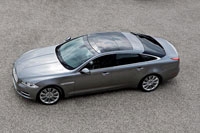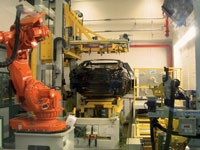When Jaguar took the wraps of its latest XJ last summer, fans of the iconic marque breathed a sigh of relief; its designers had managed to pull off that delicate automotive balancing act of moving forward while embracing the past.

As well as some fairly radical changes to the shape of the car, one of its defining features is a ’panoramic’ reinforced-glass roof. Positioning, inserting and bonding this to the car’s aluminium body presented Jaguar with a series of production challenges.
To solve these issues, Jaguar joined forces with automation specialist Excel Automation to develop a complex automated conveying and handling system.

Excel, which enlisted the help of automation and control specialist MacDonald Humphrey Automation and precision tooling and robotics group Expert Tooling, then set about working with Jaguar on a detailed project for the roof insertion system.
A key requirement of the project was that the new automated roof insertion cell be introduced into the existing overhead conveyor system that brings bodies to the trim and final assembly line; and that this was achieved without changing the functionality and efficiency of the transportation systems and assembly processes. It had to be achieved without any disruption to the production of the existing XJ model.
To facilitate the fitting of the roof, the structure and operation of one of the elevators in the body delivery conveyor has been modified to allow XJ bodies to be removed and lowered to ground-floor level, where a robot-controlled panoramic roof insertion cell, designed by Expert Tooling, has been installed to bring roof and car together.
These changes involved introducing a new elevator through the roof of the building using a 100-tonne telescopic crane. Excel designed and manufactured the new elevator, which required an increased lifting stroke of about 7m to enable it to service the ground-floor and firstand second-floor levels. Excel also project-managed the operation, including rewiring and re-commissioning, during a two-week shutdown period. The new elevator was operating successfully with the existing systems when the assembly line was restarted.
Adding the roof cell to the new XJ model had to be achieved without disruption to the production of the existing model
Sunroofs are introduced to the new cell on specially designed platens via an Excel two-tier chain conveyor and lifter system. They are positioned and inserted using mechanical centralising methods and robot techniques, rather than camera vision systems. This was the preferred option to ensure the accuracy and repeatability of this process, according to Expert’s Terry Davidson. ’A vision system would measure the roof aperture, adjust the programming of the robot, then try to fit the roof based on those measurements,’ he said. ’However, the absence of sharp body features on the flowing lines of the XJ make it difficult for a vision system to operate effectively.’
The system centralises the roof panel using an ABB robot and a special gripper featuring a ’floating’ joint. With this method, the glass roof is always suspended above the car in a known position on the gripper, and the roof aperture of the car is also in a known position below. The gripper joint is programmed to unlock and move into position on the car, rather than trying to move the whole robot to the car. Before insertion, the roof is heated to the specific temperature required for the polyurethane adhesive used in the bonding process. The robot then positions the roof underneath an SCA Schucker applicator and the adhesive is applied.

The completed roof unit is then lowered to meet the roof aperture of the XJ body below. At this point, the special joint on the gripper disengages, allowing it to ’float’. The floating gripper ensures the roof is in the correct position to locate accurately with the aperture in the vehicle body. Weights are then applied for four seconds to complete the gluing process and ensure that car and roof are perfectly bonded. With its roof fitted, the body is fed back up into the body delivery system via the Excel conveyor to continue its journey through assembly.
The robot and the adhesive system that bonds the roof to the car body are interfaced to a PLC via Interbus protocols to create an integrated and reliable system. When the roof insertion process is completed, the finished vehicle is transported back to the assembly line on the first floor, where it undergoes the normal assembly process.
Excel chief executive Geoff Hunt said: ’We take the XJ body out of the existing overhead assembly system, bring it down to floor level, fit the roof and feed it back into the system in one unmanned operation. It really is quite a feat of engineering.’
Production Essentials
The key facts to take away from this article
- A reinforced-glass roof has been bonded to the XJ’s aluminium body
- Jaguar teamed up with Excel to develop an automated conveyor
- Sunroofs are introduced to the new cell on platens via a two-tier system
- The car’s roof panel is centralised using an ABB robot and special gripper
what’s new in automation
For hundreds more stories like these visit www.engineeringtalk.com
All hands to the pump
Pump control software supplied by ABB is helping Severn Trent Water (STW) make savings of up to £2,400 a week on pump maintenance. Having experienced a number of costly blockages in its four submersible foul pumps, STW turned to ABB, which suggested its anti-Jam software, a module of its Intelligent Pump Control software. The Anti-Jam software performs cleaning cycles every time the pump starts. Each cycle consists of a series of rapid ramp-ups in both forward and reverse directions. Following the installation of the software in February, STW has not experienced a single blockage of the foul pumps. www.abb.co.uk
Torque it up
Omron Electronics’ MX2 inverter drive has been developed for machine applications. The inverter drives provide motor control features such as 200 per cent starting torque, torque control in open loop, induction motor and permanent magnet motor control, one-parameter auto-tuning, drive sequence programming and built-in position control functionality. The MX2 uses current vector technology and offers a starting torque of 200 per cent at 0.5Hz. Industrial standard networks such as Profibus, Devicenet, Ethercat or Component can be integrated. MX2 drives use current vector technology and offer a starting torque of 200 per cent at 0.5Hz combined with open-loop torque control characteristics. www.omron.co.uk
Drive time
The Allen-Bradley Powerflex 753 AC drive from Rockwell Automation provides motor control for general-purpose applications. The second release in the Allen-Bradley Powerflex 750 Series, the drive, which supports multiple languages and complies with global standards and certifications, is suitable for various applications, including fans, pumps and conveyors. The drive offers many control hardware options. Allen-Bradley Devicelogix control technology helps meet the requirements of standalone applications by giving users the flexibility to combine inputs and/or outputs, as well as local logic functions, to determine the drive’s behaviour. Users can configure the drive to provide the advanced notification of operating data on cooling fans, input/output relay cycles, motor runtime hours and potential fault warnings. www.rockwellautomation.co.uk
Made to measure
National Instruments (NI) has released two Compact RIO programmable automation controllers, which are said to offer an ideal solution for measurement and control applications operating at extended temperatures. The NI cRIO-9023 and NI cRIO-9025 real-time controllers are available with conformal coatings for the protection of components and circuitry within harsh conditions. The controllers provide even more processing for advanced measurement and control applications in temperatures between -40oC and +70oC. Both work with the existing Compact RIO reconfigurable chassis, which include field-programmable gate arrays that are programmed using the NI Labview 2009 graphical system design platform. Using Labview and Compact RIO, engineers can implement custom analogue and digital control loops, along with high-speed signal-processing algorithms, to meet their advanced measurement application needs. www.ni.com




Project to investigate hybrid approach to titanium manufacturing
What is this a hybrid of? Superplastic forming tends to be performed slowly as otherwise the behaviour is the hot creep that typifies hot...